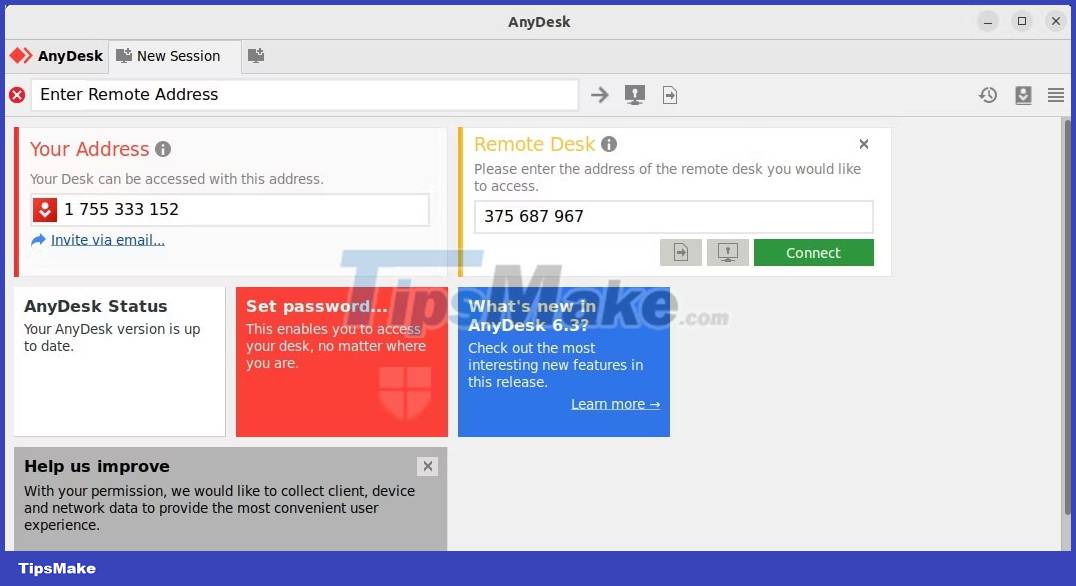How to install and use AnyDesk on Linux
You can share files with the remote system, launch applications on it, chat with users on the other end, and even share your screen.
With AnyDesk, you can bring the remote system's desktop to your local device's screen and work on it as if you were sitting in front of it. All you need is to install and run AnyDesk on both local and remote systems.
Let's see how to install and use AnyDesk on Linux.
Install AnyDesk on Ubuntu, Debian or Linux Mint
AnyDesk is not available in the default repositories of Debian-based distributions. However, you can install it from the AnyDesk repository or use the DEB package available on the AnyDesk website.
Follow one of the following methods to install AnyDesk on Debian-based distributions such as Ubuntu and Linux Mint.
1. Through AnyDesk repository
To install AnyDesk from the official repository, you first need to add the repository and its GPG key. To add a GPG key, open a terminal and run:
wget -qO - https://keys.anydesk.com/repos/DEB-GPG-KEY | sudo apt-key add -Add the repository to your system's sources list by running:
echo "deb http://deb.anydesk.com/ all main" | sudo tee /etc/apt/sources.list.d/anydesk-stable.listOnce done, update the APT package index with:
sudo apt updateNow, you can install AnyDesk on your system using:
sudo apt install anydesk
2. Use AnyDesk DEB package
To install AnyDesk using a DEB package, download the installation package from the AnyDesk website:
Then use the dpkg command to install the DEB package:
sudo dpkg -i anydesk_*_amd64.debIn case you receive any error related to dependencies, run:
sudo apt -f installInstall AnyDesk on RHEL and openSUSE based systems
On openSUSE and RPM-based distributions such as RHEL, CentOS, and Fedora, you can install AnyDesk by adding the RPM repository and then installing it using the default package manager.
Create the AnyDesk.repo repo file in the /etc/yum.repos.d directory using nano, Vim or any other editor:
sudo nano /etc/yum.repos.d/AnyDesk.repoFor openSUSE, create this repo file in your current terminal directory by running:
sudo nano AnyDesk.repoAdd the following lines to the file:
[anydesk] name=AnyDesk - stable baseurl= gpgcheck=1 repo_gpgcheck=1 gpgkey=https://keys.anydesk.com/repos/RPM-GPG-KEYDepending on the Linux distribution you use, edit the baseurl line in the above file to look like this:
On RHEL:
baseurl=http://rpm.anydesk.com/rhel/$releasever/$basearch/On CentOS:
baseurl=http://rpm.anydesk.com/centos/$releasever/$basearch/On Fedora:
baseurl=http://rpm.anydesk.com/fedora/$basearch/On openSUSE:
baseurl=http://rpm.anydesk.com/opensuse/$basearch/Once completed, save and close the file. After creating the archive files, you can install AnyDesk using the system's package manager.
To install AnyDesk on RHEL/CentOS/Fedora, use the dnf command:
sudo dnf install anydeskOn older distributions like CentOS 7, RHEL 7, and Fedora 21, you can use YUM to install AnyDesk:
sudo yum install anydeskTo install AnyDesk on openSUSE, you first need to add the repository to your system's software repositories:
zypper addrepo --repo AnyDesk.repoYou can then install AnyDesk on your system using Zypper:
sudo zypper install anydeskHow to use AnyDesk on Linux
Before continuing, ensure that AnyDesk is installed and running on both the local and remote systems. Launch AnyDesk from the applications menu to get started.
On the left side of the AnyDesk interface, you will see a 9-digit number in Your Address. This is the ID of the local system where you are sitting. You will need to share this ID with others if you want them to connect to your system. Similarly, if you need to connect to a remote system, you will need their ID.
To connect to another system, enter that system's ID in the Remote Desk field on your local AnyDesk window and click Connect.

If the ID provided is valid, you need to accept the connection request on the other machine. After accepting the request, the connection will be established.

You can also set up unattended access if no one at the remote system physically accepts the connection. On the system you want to access remotely, open AnyDesk and click Set Password. This will open the Settings window.
In the Security tab , check the Enable unattended access box . Then set a password for it. From now on, when you need to connect to this remote system, you will only have to use this password.
You should read it
- What is AnyDesk? Differences between AnyDesk and TeamViewer
- How to control a remote computer by phone with AnyDesk Remote
- How to use AnyDesk Remote to control remote computers
- How to control a remote computer with AnyDesk Remote
- Invite to download and experience AnyDesk Remote, a free application that supports remote control of smartphones for smartphones
- How to install and use Kali Linux on VmWare virtual machine
 How to create and delete folders in Linux Terminal
How to create and delete folders in Linux Terminal How to install and use GNU nano to edit files on Linux
How to install and use GNU nano to edit files on Linux How to Install and Use Homebrew on Linux
How to Install and Use Homebrew on Linux How to use multiple external monitors on Ubuntu
How to use multiple external monitors on Ubuntu How to access Linux files on iOS and Android
How to access Linux files on iOS and Android 9 best audio editing software for Linux
9 best audio editing software for Linux